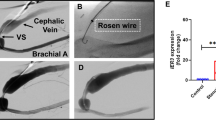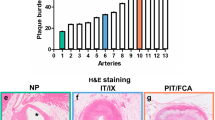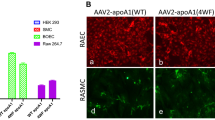Abstract
Though the efficacy of intravascular gene transfer has been demonstrated in native vessels following acute injury, this methodology has not been validated in complex models of vascular injury that more closely mimic clinical angioplasty procedures. Previous studies have shown that Gax gene overexpression modulates the injury-induced remodeling of the vessel in rat carotid and normal rabbit iliac arteries. Here, we evaluated the effect of the Gax gene delivery in atheromatous stented vessels. Rabbits were fed 120 g daily of 1% cholesterol diet for 3 weeks. At 1 week they underwent initial injury on the external iliac artery, then balloon angioplasty was performed at 3 weeks at the same site with a 2.5 mm diameter channel balloon catheter (three times 1 min at 6 atm). Either saline (n = 4) or the control viral construct Ad-CMVluc (5 × 109p.f.u.) (n = 5) or Ad-CMVGax (5 × 109 p.f.u.) (n = 4) was delivered with a poloxamer mixture via a channel balloon (6 atm, 30 min), and a 15 mm long Palmaz–Schatz stent (PS154) was then deployed at the site (1 min, 8 atm). Arteries were analyzed 1 month later. At 1 month, the Ad-CMVGax treated arteries exhibited a lower maximal intimal area (1.15 ± 0.1 mm2) than saline (1.87 ± 0.15 mm2, P = 0.007) or Ad-CMVluc-treated vessels (1.98 ± 0.31 mm2, P = 0.04). Likewise Ad-CMVGax-treated vessels displayed a lower maximal percentage cross-sectional area narrowing (35.1 ± 3.5%) than saline (65.3 ± 9.4%, P = 0.01) or Ad-CMVluc-treated vessels (62.7 ± 6.7%, P = 0.02). Angiographic analysis revealed larger minimal lumen diameter in Ad-CMVGax treated arteries (2.0 ± 0.1 mm) than saline (1.14 ± 0.36 mm, P = 0.06) or Ad-CMVluc-treated vessels (1.23 ± 0.25 mm, P = 0.02). Overexpression of the Gax gene inhibits neointimal hyperplasia and lumen loss in atheromatous stented rabbit iliac arteries.
This is a preview of subscription content, access via your institution
Access options
Subscribe to this journal
Receive 12 print issues and online access
$259.00 per year
only $21.58 per issue
Buy this article
- Purchase on Springer Link
- Instant access to full article PDF
Prices may be subject to local taxes which are calculated during checkout







Similar content being viewed by others
References
Nobuyoshi M et al. Restenosis after successful percutaneous transluminal coronary angioplasty: serial angiographic follow-up of 229 patients J Am Coll Cardiol 1988 12: 616–623
Dussaillant GR et al. Small stent size and intimal hyperplasia contribute to restenosis: a volumetric intravascular ultrasound analysis J Am Coll Cardiol 1995 26: 720–724
Hoffmann R et al. Patterns and mechanisms of in-stent restenosis. A serial intravascular ultrasound study Circulation 1996 94: 1247–1254
Serruys P et al. A comparison of balloon expandable-stent implantation with balloon angioplasty in patients with coronary artery disease New Engl J Med 1994 331: 489–495
Fischman DL et al. A randomized comparison of coronary-stent placement and balloon angioplasty in the treatment of coronary artery disease New Engl J Med 1994 331: 469–501
Maillard L, Walsh K . Growth-arrest homeobox gene Gax: a molecular strategy to prevent arterial restenosis Schweiz Med Wochenschr 1996 126: 1721–1726
Gorski DH, Walsh K . Mitogen-responsive nuclear factors that mediate growth control signals in vascular myocytes Cardiovasc Res 1995 30: 585–592
Walsh K, Perlman H . Molecular strategies to inhibit restenosis: modulation of the vascular myocyte phenotype Semin Interv Cardiol 1996 1: 173–179
Gorski DH, Patel CV, Walsh K . Homeobox transcription factor regulation in the cardiovascular system Trends Cardiovasc Med 1993 3: 184–190
Gorski DH et al. Molecular cloning of a diverged homeobox gene that is rapidly down-regulated during the G0/G1 transition in vascular smooth muscle cells Mol Cell Biol 1993 13: 3722–3733
LePage DF et al. Molecular cloning and localization of the human GAX gene to 7p21 Genomics 1994 24: 535–540
Gorski DH, LePage DF, Walsh K . Cloning and sequence analysis of homeobox transcription factor cDNAs with an inosine-containing probe Biotechniques 1994 16: 856–865
Skopicki HA et al. Embryonic expression of the Gax homeodomain protein in cardiac, smooth, and skeletal muscle Circ Res 1997 80: 452–462
Andres V et al. Regulation of Gax homeobox gene transcription by a combination of positive factors including myocyte-specific enhancer factor 2 Mol Cell Biol 1995 15: 4272–4281
Weir L et al. Expression of Gax, a growth-arrest homeobox gene, is rapidly down-regulated in the rat carotid artery during the proliferative response to balloon injury J Biol Chem 1995 270: 5457–5461
Yamashita J et al. Opposite regulation of Gax homeobox expression by angiotensin II and C-type natriuretic peptide Hypertension 1997 29: 381–387
Zhan Q et al. The gadd and MyD genes define a novel set of mammalian genes encoding acidic proteins that synergistically suppress cell growth Mol Cell Biol 1994 14: 2361–2371
Del Sal G et al. The growth arrest-specific gene, gas1, is involved in growth suppression Cell 1992 70: 595–607
Barone MV et al. CHOP (GADD153) and its oncogenic variant, TLS-CHOP, have opposing effects on the induction of G1/S arrest Genes Dev 1994 8: 453–464
Smith RC et al. p21cip1-mediated inhibition of cell proliferation by overexpression of the gax homeodomain gene Genes Dev 1997 11: 1674–1689
Maillard L et al. Percutaneous delivery of the gax gene inhibits vessel stenosis in a rabbit model of balloon angioplasty Cardiovasc Res 1997 35: 536–546
Witzenbichler B et al. Regulation of smooth muscle cell migration and integrin expression by the Gax transcription factor J Clin Invest 1999 104: 1469–1480
French BA et al. Percutaneous transluminal in vivo gene transfer by recombinant adenovirus in normal porcine coronary arteries, atherosclerotic arteries, and two models of coronary restenosis Circulation 1994 90: 2402–2413
Feldman LJ et al. Low efficiency of percutaneous adenovirus-mediated arterial gene transfer in the atherosclerotic rabbit J Clin Invest 1995 95: 2662–2671
Casscells W et al. Amphotropic but not atherotropic: another caveat for adenoviral gene therapy J Clin Invest 1995 95: 2425–2426
Simari RD et al. Regulation of cellular proliferation and intimal formation following balloon injury in atherosclerotic rabbit arteries J Clin Invest 1996 98: 225–235
Steg PG et al. Reduction of restenosis after angioplasty in an atheromatous model by suicide gene therapy Circulation 1997 96: 408–411
van der Giessen WJ, Serruys PW, Visser WJ . Endothelialization of intravascular stents J Intervent Cardiol 1988 1: 109–120
Dichek DA et al. Seeding of intravascular stents with genetically engineered endothelial cells Circulation 1989 80: 1347–1353
Flugelman MY et al. Genetically engineered endothelial cells remain adherent and viable after stent deployment and exposure to flow in vitro Circ Res 1992 70: 348–354
Hardhammar PA et al. Reduction in thrombotic events with heparin-coated Palmaz–Schatz stents in normal porcine coronary arteries Circulation 1996 93: 423–430
Lincoff AM, Topol EJ, Ellis SG . Local drug delivery for the preventionof restenosis. Fact, fancy, and future Circulation 1994 90: 2070–2084
Van Belle E et al. Effects of poloxamer 407 on transfection time and percutaneous adenovirus-mediated gene transfer in native and stented vessels Hum Gene Ther 1998 9: 1013–1024
Van Belle E et al. Passivation of metallic stents after arterial gene transfer of phVEGF165 inhibits thrombus formation and intimal thickening J Am Coll Cardiol 1997 29: 1371–1379
Isner JM, Feldman LJ . Gene therapy for arterial disease Lancet 1994 344: 1653–1654
Feldman LJ, Tahlil O, Steg PG . Perspectives of arterial gene therapy for prevention of restenosis Cardiovasc Res 1996 32: 194–207
Lemarchand P et al. In vivo gene transfer and expression in normal uninjured blood vessels using replication-deficient recombinant adenovirus vectors Circ Res 1993 72: 1132–1138
Guzman RJ et al. Efficient and selective adenovirus-mediated gene transfer into vascular neointima Circulation 1993 88: 2838–2848
Schneider MD, French BA . The advent of adenovirus. Gene therapy for cardiovascular disease Circulation 1993 88: 1937–1942
Barr E et al. Efficient catheter-mediated gene transfer into the heart using replication-defective adenovirus Gene Therapy 1994 1: 51–58
Rome JJ et al. Adenoviral vector-mediated gene transfer into sheep arteries using a double-balloon catheter Hum Gene Ther 1994 5: 1249–1258
Chen SJ, Wilson JM, Muller DW . Adenovirus-mediated gene transfer of soluble vascular cell adhesion molecule to porcine interposition vein grafts Circulation 1994 89: 1922–1928
Nabel EG . Gene therapy for cardiovascular disease Circulation 1995 91: 541–548
Lafont A et al. Vasomotor dysfunction early after exposure of normal rabbit arteries to an adenoviral vector Hum Gene Ther 1997 8: 1033–1040
Lee SW et al. In vivo adenoviral vector-mediated gene transfer into balloon-injured rat carotid arteries Circ Res 1993 73: 797–807
Chang MW et al. Cytostatic gene therapy for vascular proliferative disorders with a constitutively active form of the retinoblastoma gene product Science 1995 267: 518–522
Schulick AH et al. In vivo gene transfer into injured carotid arteries. Optimization and evaluation of acute toxicity Circulation 1995 91: 2407–2414
Willard JE et al. Genetic modification of the vessel wall. Comparison of surgical and catheter-based techniques for delivery of recombinant adenovirus Circulation 1994 89: 2190–2197
Steg PG et al. Arterial gene transfer to rabbit endothelial and smooth muscle cells using percutaneous delivery of an adenoviral vector Circulation 1994 90: 1648–1656
Maillard L et al. Pre-treatment with elastase improves the efficiency of percutaneous adenovirus-mediated gene transfer to the arterial media Gene Therapy 1998 5: 1023–1030
Colombo A et al. Intracoronary stenting without anticoagulation accomplished with intravascular ultrasound guidance Circulation 1995 91: 1676–1688
Karrillon GJ et al. Intracoronary stent implantation without ultrasound guidance and with replacement of conventional anticoagulation by antiplatelet therapy Circulation 1996 94: 1519–1527
Chang MW et al. Adenovirus-mediated over-expression of the cyclin/cyclin-dependent kinase inhibitor, p21 inhibits vascular smooth muscle cell proliferation and neointima formation in the rat carotid artery model of balloon angioplasty J Clin Invest 1995 96: 2260–2268
Rade JJ et al. Local adenoviral-mediated expression of recombinant hirudin reduces neointima formation after arterial injury Nature Med 1996 2: 293–298
Ohno T et al. Gene therapy for vascular smooth muscle cell proliferation after arterial injury Science 1994 265: 781–784
Guzman RJ et al. In vivo suppression of injury-induced vascular smooth muscle cell accumulation using adenovirus-mediated transfer of the herpes simplex virus thymidine kinase gene Proc Natl Acad Sci USA 1994 91: 110732–110736
Wu KK . Prostacyclin and nitric oxide-related gene transfer in preventing arterial thrombosis and restenosis Agents Actions Suppl 1997 48: 107–123
Kullo IJ et al. Expression and function of recombinant endothelial NO synthase in coronary artery smooth muscle cells Arterioscler Thromb Vasc Biol 1997 17: 2405–2412
Harrell RL et al. Inhibition of vascular smooth muscle cell proliferation and neointimal accumulation by adenovirus-mediated gene transfer of cytosine deaminase Circulation 1997 96: 621–627
Serruys PW et al. Randomised comparison of implantation of heparin-coated stents with balloon angioplasty in selected patients with coronary artery disease (Benestent II) Lancet 1998 352: 673–681
Perlman H et al. Bax-mediated cell death by the Gax homeoprotein requires mitogen activation but is independent of cell cycle activity EMBO J 1998 17: 3576–3586
Perlman H et al. Adenovirus-mediated delivery of the Gax transcription factor to rat carotid arteries inhibits smooth muscle proliferation and induces apoptosis Gene Therapy 1999 6: 758–763
Smith RC et al. Adenoviral constructs encoding phosphorylation-competent full-length and truncated forms of the human retinoblastoma protein inhibit myocyte proliferation and neointima formation Circulation 1997 96: 1899–1905
Couffinhal T et al. Histochemical staining following LacZ gene transfer underestimates transfection efficiency Hum Gene Ther 1997 8: 929–934
Clesham GJ et al. Enhancer stimulation unmasks latent gene transfer after adenovirus- mediated gene delivery into human vascular smooth muscle cells Circ Res 1996 79: 1188–1195
Quantin B et al. Adenovirus as an expression vector in muscle cells in vivo Proc Natl Acad Sci USA 1992 89: 2581–2584
Stratford-Perricaudet LD et al. Widespread long-term gene transfer to mouse skeletal muscles and heart J Clin Invest 1992 90: 626–630
Rosenfeld MA et al. In vivo transfer of the human cystic fibrosis transmembrane conductance regulator gene to the airway epithelium Cell 1992 68: 143–155
Graham FL, van der Eb AJ . A new technique for assay of infectivity of human adenovirus 5 DNA Virology 1973 52: 456–463
March KL, Madison JE, Trapnell BC . Pharmacokinetics of adenoviral vector-mediated gene delivery to vascular smooth muscle cells: modulation by poloxamer 407 and implications for cardiovascular gene therapy Hum Gene Ther 1995 6: 41–53
Feldman LJ et al. Improved efficiency of arterial gene transfer by use of poloxamer 407 as a vehicle for adenoviral vectors Gene Therapy 1997 4: 189–198
Mancini GBJ et al. Automated quantitative coronary arteriography: morphologic and physiologic validation in vivo of a rapid digital angiographic method Circulation 1987 75: 452–460
Schwartz RS et al. Restenosis and the proportional neointimal response to coronary artery injury: results in a porcine model J Am Coll Cardiol 1992 19: 267–274
Acknowledgements
This work was supported by NIH grants AR40197 and AG15052 and HL50692 to KW and NIH grants HL02824 and HL53354 to JMI. LM was supported by the French Federation of Cardiology. Eric Van Belle was the recipient of a fellowship from the French Ministry of Foreign Affairs ‘Bourse Lavoisier’ and a grant from the University Hospital of Lille. The authors gratefully acknowledge Jim Barry and Maria Palasis, Boston Scientific for providing catheters and Johnson and Johnson for providing stents. Our thanks to Aude Le Roux and Jean-Marc Guillaume for viral supply/stock production.
Author information
Authors and Affiliations
Rights and permissions
About this article
Cite this article
Maillard, L., Van Belle, E., Tio, F. et al. Effect of percutaneous adenovirus-mediated Gax gene delivery to the arterial wall in double-injured atheromatous stented rabbit iliac arteries. Gene Ther 7, 1353–1361 (2000). https://doi.org/10.1038/sj.gt.3301255
Received:
Accepted:
Published:
Issue Date:
DOI: https://doi.org/10.1038/sj.gt.3301255
Keywords
This article is cited by
-
Stent-based delivery of adeno-associated viral vectors with sustained vascular transduction and iNOS-mediated inhibition of in-stent restenosis
Gene Therapy (2017)
-
Tissue factor pathway inhibitor suppresses the growth of human vascular smooth muscle cells through regulating cell cycle
Molecular Biology Reports (2011)
-
Dysregulation of HSG triggers vascular proliferative disorders
Nature Cell Biology (2004)
-
Post-intervention vessel remodeling
Gene Therapy (2002)



